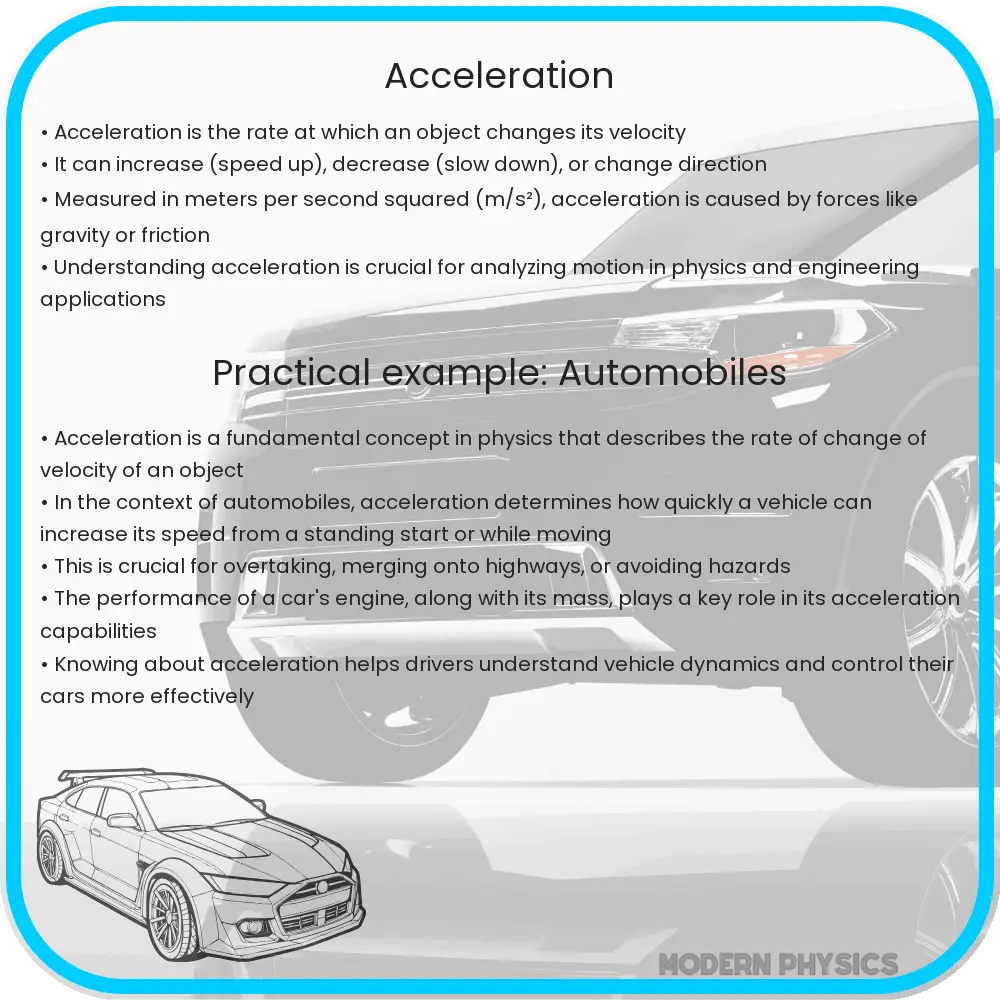Explore the fascinating world of acceleration, from its role in Newton’s laws and motion dynamics to its everyday applications and advanced theories.

Understanding Acceleration: The Core of Motion Dynamics
Acceleration is a fundamental concept in physics, central to understanding motion dynamics. It refers to the rate at which an object changes its velocity. Acceleration is not just about speed; it encompasses both changes in magnitude and direction of velocity.
Speed vs Acceleration
Often confused with speed, acceleration is distinctly different. While speed is a scalar quantity representing how fast an object is moving, acceleration is a vector quantity, indicating how the velocity of an object changes over time. This distinction is crucial in understanding motion dynamics.
Newton’s Laws of Motion
Newton’s Laws of Motion are paramount in the study of acceleration:
- First Law (Law of Inertia): An object will remain at rest or in uniform motion in a straight line unless acted upon by an external force. This law introduces the concept of inertia, which is the resistance to changes in velocity.
- Second Law: The rate of change of momentum of an object is directly proportional to the force applied, and this change occurs in the direction of the applied force. Mathematically, it’s expressed as F = ma, where F is force, m is mass, and a is acceleration.
- Third Law: For every action, there is an equal and opposite reaction. This law helps explain how forces interact in systems and contributes to our understanding of motion dynamics.
Acceleration in Motion Dynamics
Acceleration plays a key role in motion dynamics, a branch of mechanics dealing with the motion of bodies under the action of forces. It’s not just about objects speeding up; acceleration occurs when there’s any change in velocity, including slowing down (deceleration) and changing direction. This comprehensive understanding is essential for analyzing various physical phenomena, from everyday occurrences like a car speeding up on a highway to complex celestial motions.
For instance, when a car turns a corner, even if it maintains a constant speed, it’s accelerating because its direction is changing. Similarly, an object in free fall accelerates due to the force of gravity, following the equation a = g, where g is the acceleration due to gravity.
In conclusion, acceleration is a multifaceted concept that’s integral to understanding motion. Its applications span from basic transportation mechanics to sophisticated aerospace engineering, making it a cornerstone in the study of physics.
Applications and Implications of Acceleration
Acceleration is not just a theoretical concept; its applications are vast and diverse. In the realm of engineering, it is crucial for designing vehicles and structures that can withstand dynamic forces. For instance, understanding acceleration is essential for automotive safety features like airbags and ABS (Anti-lock Braking System). In aerospace engineering, accurate calculations of acceleration are vital for the launch and navigation of spacecraft.
Acceleration in Everyday Life
Everyday experiences are often explained through acceleration. The sensation of being pushed back into your seat when a car accelerates, or the feeling of weightlessness on a rollercoaster, are practical demonstrations of acceleration’s effects on the human body. In sports, athletes’ performances, like a sprinter’s burst of speed or a diver’s leap, are also examples of acceleration in action.
Advanced Concepts in Acceleration
Beyond basic mechanics, acceleration is a key element in advanced physics theories. In Einstein’s theory of relativity, for example, acceleration plays a crucial role. The equivalence principle, a core idea in general relativity, postulates that the effects of gravity are indistinguishable from the effects of acceleration, blending the concept into the fabric of spacetime.
Environmental and Societal Implications
Understanding acceleration is also significant for environmental and societal considerations. For instance, the acceleration of vehicles contributes to greenhouse gas emissions, influencing climate change policies and automotive industry standards. Moreover, the concept of acceleration extends into economic and cultural domains, metaphorically used to describe rapid changes in these spheres.
Conclusion
In summary, acceleration is a multifaceted concept with extensive applications and implications in various fields. From providing fundamental insights into motion dynamics to its practical applications in engineering, sports, and advanced physics, acceleration is a cornerstone in our understanding of the physical world. Its relevance extends beyond pure science, influencing environmental policies and reflecting societal changes. As such, a thorough comprehension of acceleration and its principles is invaluable, offering a deeper appreciation of the intricacies of motion and the forces that govern our universe.
